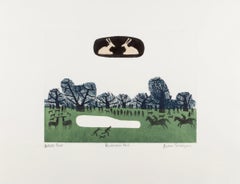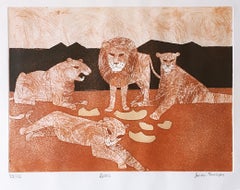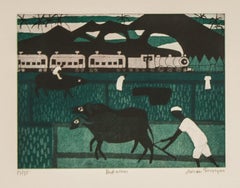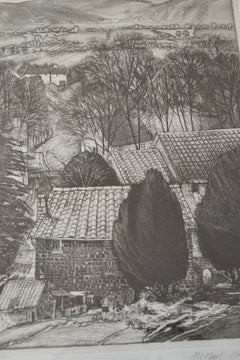Julian Trevelyan Animal Prints
British, 1910-1988
Julian Trevelyan was an important British artist in the twentieth century.
The only child of Robert Calverley Trevelyan and his wife Elizabeth van der Hoeven, his grandfather was the liberal politician Sir George Otto Trevelyan and his uncle was the historian George Macaulay Trevelyan.
Trevelyan was educated at Bedales School and Trinity College, Cambridge, where he read English Literature. He moved to Paris to become an artist and enrolled at Atelier Dix-Sept, Stanley William Hayter's engraving school, where he learned about etching. He worked alongside artists including Max Ernst, Oskar Kokoschka, Joan Miró and Pablo Picasso.
In 1935, Trevelyan bought Durham Wharf, a group of warehouses beside the River Thames in Hammersmith, London. The place became his home and studio for the rest of his life as well as a source of endless artistic inspiration. He became a confirmed Surrealist and exhibited at the International Surrealist Exhibition, which was held at the New Burlington Galleries in London.
Trevelyan married Ursula Darwin, daughter of Bernard Darwin and great-granddaughter of Charles Darwin, but their marriage was dissolved in 1950. Their son is the film-maker Philip Trevelyan. It was in 1951 that he married the woman who became his most renowned collaborator and muse, Mary Fedden.
From 1950 to 1955, Trevelyan taught history of art and etching at the Chelsea School of Art. Between 1955 and 1963 he was tutor of engraving at the Royal College of Art, before rising to Head of the etchings department and becoming influential to many younger printmakers, including David Hockney and Norman Ackroyd.
In July 1986, Trevelyan was awarded a senior fellowship at the Royal College of Art and in September 1987 he was appointed a Royal Academician.
A Trevelyan retrospective, The Artist and His World, was held at Pallant House Gallery, Chichester in 2018.
His son has written a monograph on Trevelyan, 'Picture Language', published in 2013 by Lund Humphries.to
2
1
Overall Width
to
Overall Height
to
1
1
38
194
161
118
94
2
1
2
3
3
2
1
1
1
1
1
1
1
1
3
1
2
2
1
Artist: Julian Trevelyan
Richmond Park, from London Parks, Landscape with Horses and Deer Print, 1969-70
By Julian Trevelyan
Located in Kingsclere, GB
Richmond Park, from London Parks by Julian Trevelyan, 1969-70
Additional information:
Medium: etching, aquatint and soft-ground (unframed)
58.5 x 77 cm
23 1/8 x 30 1/4 in
signed, ti...
Category
21st Century and Contemporary Julian Trevelyan Animal Prints
Materials
Etching
Lions ( Turner 194), Etching and aquatint by top British artist Signed/N Framed
By Julian Trevelyan
Located in New York, NY
Julian Trevelyan
Lions ( Turner 194), 1966-1967
Color etching and aquatint on T.H. Saunders paper
Pencil signed and numbered 28 from the limited edition of 125
Frame Included: held i...
Category
1960s Modern Julian Trevelyan Animal Prints
Materials
Etching, Aquatint
Buffaloes original 1968 limited ed. aquatint etching by Julian Trevelyan
By Julian Trevelyan
Located in Paonia, CO
Buffaloes is a signed limited edition ( 13/75 ) aquatint etching by British artist and poet Julian Trevelyan. Several buffaloes and workers are in a field with mountains a...
Category
1960s Expressionist Julian Trevelyan Animal Prints
Materials
Etching
Related Items
The Vegetal Cow - Etching, Ltd 75 copies
By Mordecai Moreh
Located in Paris, IDF
Mordecaï Moreh (1937-)
The Vegetal Cow
Original etching and aquatint
Handsigned in pencil
Numbered / 75 copies
On vellum BFK Rives 45 x 56 cm (c. 17.7...
Category
Late 20th Century Modern Julian Trevelyan Animal Prints
Materials
Etching, Aquatint
Italian Summer, Framed Etching by Michael Chapman
By Michael James Chaplin
Located in Brecon, Powys
Etching from the studio of this acclaimed British Watercolorist.
Good condition. Image 15.5" x 11.5"
English artist Michael Chaplin is a Member of the Royal Watercolor Society, pa...
Category
1990s Realist Julian Trevelyan Animal Prints
Materials
Etching
$360 Sale Price
20% Off
H 21.25 in W 17.25 in
LOBSTER and OCTOPUS (KAMPF - BATTLE)
By Norbertine Bresslern-Roth
Located in Santa Monica, CA
NORBERTINE VON BRESSLERN-ROTH (1891 1978)
KAMPF (BATTLE - LOBSTER and OCTOPUS) c. 1928
Color linoleum cut Signed in pencil. Image 8 5/8 x 8 11/16”
In excellent condition and full ...
Category
1920s Vienna Secession Julian Trevelyan Animal Prints
Materials
Linocut
"Winter Wildfowling" Frank Weston Benson, Hunting Scene, Outdoors, Marshes
By Frank Weston Benson
Located in New York, NY
Frank Weston Benson
Winter Wildfowling, 1927
Signed lower left
Etching on paper
Image 8 1/2 x 7 inches
Born in Salem, Massachusetts, a descendant of a long line of sea captains, Benson first studied art at Boston’s Museum School where he became editor of the student magazine. In 1883, Benson enrolled at the Académie Julian in Paris where artists such as Bouguereau, Lefebvre, Constant, Doucet and Boulanger taught students from all over Europe and America. It was Boulanger who gave Benson his highest commendation. “Young man,” he said, “Your career is in your hands . . . you will do very well.” Benson’s parents gave him a present of one thousand dollars a twenty-first birthday and told him to return home when it ran out. The money lasted long enough to provide Benson with two years of schooling in Paris, a summer at the seaside village of Concarneau in Brittany and travel in England.
Upon returning to America, Benson opened a studio on Salem’s Chestnut Street and began painting portraits of family and friends. An oil of his wife, Ellen Perry Peirson, dressed in her wedding gown is representative of this period. It demonstrates not only the academic techniques he learned at the Academie Julian but also his own growing emphasis on the effects of light. And yet, despite all the technical mastery displayed in the work, the painting exudes the warmth that existed between model and artist. More than a likeness, it is a study in serenity. Perhaps it was of a work such as this that Benson was thinking when he said, “The more a painter knows about his subject, the more he studies and understands it, the more the true nature of it is perceived by whoever looks at it, even though it is extremely subtle and not easy to see or understand. A painter must search deeply into the aspects of a subject, must know and understand it thoroughly before he can represent it well.”
Following a brief stint as an instructor at the Portland, Maine, Society of Art, Benson was appointed as instructor of antique drawing at the Museum School in Boston in the spring of l889. Benson’s long association with the school was particularly fruitful. Under the leadership of Edmund Tarbell and Benson the Museum School became a national and internationally recognized institution. The students won numerous prizes, enrollment tripled, a new school building was erected and visiting delegations from other schools sought the secret of their success. Benson cherished his role as teacher and was held in high esteem by his students, many of whom called him “Cher Maitre.” Reminiscing about his long career with the school Benson once said, “I may have taught many students, but it was I who learned the most.”
In 1890, Benson won the Hallgarten Prize at the National Academy in New York. It was the first of a long series of awards, that earning for him the sobriquet “America’s Most Medalled Painter.” In the early years of his career, Benson’s studio works were mostly portraits or paintings of figures set in richly appointed interiors. Young women in white stretch their hands out towards the glow of an unseen fire; girls converse on an antique settee in a room full of objets d’arts; his first daughter, Eleanor, poses with her cat. Works of this sort, together with a steady influx of portrait commissions, earned Benson both renown and financial rewards, yet it was in his outdoor works that gave Benson his greatest pleasure.
In the latter half of the 1890s, Benson summered in Newcastle, on New Hampshire’s short stretch of seacoast. It was here, in 1899, that Benson made his first foray into impressionism with Children in the Woods and The Sisters, the latter a sun-dappled study of his two youngest daughters, Sylvia and Elisabeth.
This painting was one of the first works that Benson hung at an exhibition with nine friends. The resignation of these ten illustrious artists rocked the American art establishment but, the catalogue for their first exhibition was titled, simply, “Ten American Painters.” When, in 1898, the three Bostonians and seven New Yorkers began to exhibit their best work in exquisitely arranged small shows, the group (dubbed by newspapers, “The Ten” ) quickly became known as the American Impressionists, a bow to the style of their French predecessors. The Ten’s annual shows soon became an eagerly awaited part of the annual exhibition calendar and were always well reviewed. Held annually in New York City, the group’s yearly exhibitions usually traveled to Boston and were occasionally seen in other cities. Benson’s association with other members of the group such as Childe Hassam, Thomas Dewing, William Merrit Chase and J. Alden Weir, only reinforced his growing emphasis on the tenets of Impressionism. As he later said to his daughter Eleanor, “I follow the light, where it comes from, where it goes.”
The principles of Impressionism began to dominate Benson’s work by 1901, the year that the Bensons first summered on the island of North Haven in Maine’s Penobscot Bay. His summer home “Wooster Farm,” which they rented and finally bought in 1906, became the setting for some of Benson’s best known work and there, it seemed, he found endless inspiration. Benson’s sparkling plein-air paintings of his children–Eleanor, George, Elisabeth and Sylvia–capture the very essence of summer and have been widely reproduced: In The Hilltop, George and Eleanor watch the sailboat races from the headland near their house.
As a boy, Benson dreamed of being an ornithological illustrator. In mid-life, he returned to the wildfowl and sporting subjects that had remained his lifelong passion. Using etching and lithography, watercolor, oil and wash, Benson portrayed the birds observed since childhood and captured scenes of his hunting and fishing expeditions.
Together with his two brothers-in-law, Benson bought a small hunting retreat on a hill overlooking Cape Cod’s Nauset Marsh. Here, in the late 1890s, he began experimenting with black and white wash drawings. These paintings became so popular that Benson was not able to keep up with the demand. He turned to an art publishing company to have several made into it intaglio prints; twelve wash drawings are known to have been reproduced in this manner. At least two of them were given as gifts to associate members of the Boston Guild of artists, of which Benson was a founding member.
Benson was also an avid fisherman and his salmon fishing expeditions to Canada’s Gaspé Peninsula where one of the high points of his summer. There, in 1921, he began the first in a series of watercolors that would eventually over 500 works.
Benson’s watercolors conveyed the joy and beauty of a sportsman’s life whether in a painting of a hunter setting out decoys, a flock of ducks coming in for a landing or a grouse flushed from cover. The critics favorably compared Benson’s watercolors to those of Homer. “The love of the almost primitive wilderness which appears in many of Homer’s landscapes and the swift, sure touch with which he suggests rather than describes–these also characterize Benson’s work,” one critic wrote. “The solitude of the northern woods is very much like Homer’s.”
Like the wash drawings before them, Benson’s watercolors proved...
Category
1920s Academic Julian Trevelyan Animal Prints
Materials
Paper, Etching
Salvador Dali, Le Cerf Malade Signed Etching Engraving, Color Lithograph Pochoir
By Salvador Dalí
Located in Surfside, FL
An original signed drypoint etching with color pochoir by Spanish artist Salvador Dali titled "La Cerf Malade", depicting a stag deer, from the Portfolio: Le Bestiaire de la Fontaine...
Category
1970s Surrealist Julian Trevelyan Animal Prints
Materials
Color, Drypoint, Etching
$3,600
H 35.5 in W 27.75 in
Salvador Dalí, "Le Chateau de Gala", original etching, hand colored, signed
By Salvador Dalí
Located in Chatsworth, CA
Salvador Dalí
Le Chateau de Gala (Gala's Castle) from After 50 Years of Surrealism
Original etching, hand colored
1974
Image size: 15 3/...
Category
1970s Modern Julian Trevelyan Animal Prints
Materials
Etching
$4,400 Sale Price
44% Off
H 26 in W 19.75 in
Lumbermen.
By Edmund Blampied
Located in Storrs, CT
Lumbermen. 1923. Etching. Appleby 91. 9 x 12 (sheet 12 3/8 x 18 1/8). Edition 100. A cleanly-wiped impression printed on off-white 'FG Head & Co' laid paper with full margins. Signed...
Category
1920s Modern Julian Trevelyan Animal Prints
Materials
Drypoint, Etching
Meadow-Limited Edition Etching, Signed by Artist
By Russa Graeme
Located in Chesterfield, MI
Limited Edition Etching (125/200). Signed by Artist. Measures 32.75 x 25.5 inches and is unframed. The piece is in Fair/Distressed Condition-discoloration/yellowing primarily in the ...
Category
Late 20th Century Julian Trevelyan Animal Prints
Materials
Etching
$320 Sale Price
20% Off
H 32.75 in W 25.5 in
The Goldfinch, 1942 (Histoire Naturelle - Textes de Buffon, B.348 )
By Pablo Picasso
Located in Greenwich, CT
The Goldfinch is an aquatint and drypoint print on chine from one of the deluxe copies of Picasso's 1942 Histoire Naturelle - Textes de Buffon series. The image size is 11.2 x 8.25 inches, unsigned as issued, and framed in a contemporary silver and gray moulding. One of about 36 prints that exist with Picasso's remarqued title in French, from the edition of 262 (there were 226 portfolios, some with additional sets on varying papers).
Catalogue - Cramer #37
The exceptional etchings from Picasso’s Histoire Naturelle – Textes de Buffon are a masterful combination of sugar-lift aquatint and drypoint, showcasing a full range of gray tonalities. The etchings of animals, birds and insects are considered some of the most beautiful and most unusual examples of Picasso’s graphic work.
Roger Lacourière, Picasso’s master printer, pulled the prints for each etching between 1939-1942. It was Lacourière who taught Picasso the sugar-lift aquatint technique which allowed him to mimic the effect of brushstrokes in these etched images. Picasso first explored the technique in his plates for the Vollard Suite, but it was in the creation of the Buffon images that he fully realized its stunning, painterly potential.
For the edition, 226 portfolios were produced with the first thirty-six counting as deluxe compilations. These rare deluxe sets were on diverse papers (chine, japon or vergé ancien) and each included a complete additional suite showing Picasso’s title remarques along the bottom. As such, the remarqued versions of the prints are quite rare with just thirty-six of each produced for the edition (with the exception of The Wolf which is never remarqued – the image always fills the entire etching plate).
These prints are based on the writings of French naturalist Georges-Louis Leclerc, Comte de Buffon, who extensively documented the natural world in his monumental work Histoire Naturelle. Picasso’s association with the project to illustrate parts of the Buffon came during a tumultuous time in European history – the prelude to, and early years of, World War II. As the continent was ravaged, Picasso lived through the disaster in Paris, which the Germans occupied in 1940. These prints could be seen as a political statement – Picasso channeling his artistic expression into a form of resistance art...
Category
20th Century Modern Julian Trevelyan Animal Prints
Materials
Drypoint, Aquatint
$12,850
H 24.125 in W 20.5 in
The Lobster, 1942 (Histoire Naturelle - Textes de Buffon, B.352)
By Pablo Picasso
Located in Greenwich, CT
The Lobster is an aquatint and drypoint print on chine from one of the deluxe copies of Picasso's 1942 Histoire Naturelle - Textes de Buffon series. The image size is 10.6 x 7.9 inches, unsigned as issued, and framed in a contemporary silver and gray moulding. One of about 36 prints that exist with Picasso's remarqued title in French, from the edition of 262 (there were 226 portfolios, some with additional sets on varying papers).
Catalogue - Cramer #37
The exceptional etchings from Picasso’s Histoire Naturelle – Textes de Buffon are a masterful combination of sugar-lift aquatint and drypoint, showcasing a full range of gray tonalities. The etchings of animals, birds and insects are considered some of the most beautiful and most unusual examples of Picasso’s graphic work.
Roger Lacourière, Picasso’s master printer, pulled the prints for each etching between 1939-1942. It was Lacourière who taught Picasso the sugar-lift aquatint technique which allowed him to mimic the effect of brushstrokes in these etched images. Picasso first explored the technique in his plates for the Vollard Suite, but it was in the creation of the Buffon images that he fully realized its stunning, painterly potential.
For the edition, 226 portfolios were produced with the first thirty-six counting as deluxe compilations. These rare deluxe sets were on diverse papers (chine, japon or vergé ancien) and each included a complete additional suite showing Picasso’s title remarques along the bottom. As such, the remarqued versions of the prints are quite rare with just thirty-six of each produced for the edition (with the exception of The Wolf which is never remarqued – the image always fills the entire etching plate).
These prints are based on the writings of French naturalist Georges-Louis Leclerc, Comte de Buffon, who extensively documented the natural world in his monumental work Histoire Naturelle. Picasso’s association with the project to illustrate parts of the Buffon came during a tumultuous time in European history – the prelude to, and early years of, World War II. As the continent was ravaged, Picasso lived through the disaster in Paris, which the Germans occupied in 1940. These prints could be seen as a political statement – Picasso channeling his artistic expression into a form of resistance art...
Category
20th Century Modern Julian Trevelyan Animal Prints
Materials
Drypoint, Aquatint
$12,850
H 24.125 in W 20.5 in
The Deer, 1942 (Histoire Naturelle - Textes de Buffon, B.336)
By Pablo Picasso
Located in Greenwich, CT
The Deer is an aquatint and drypoint print on chine from one of the deluxe copies of Picasso's 1942 Histoire Naturelle - Textes de Buffon series. The image size is 10.5 x 8.15 inches, unsigned as issued, and framed in a contemporary silver and gray moulding. One of about 36 prints that exist with Picasso's remarqued title in French, from the edition of 262 (there were 226 portfolios, some with additional sets on varying papers).
Catalogue - Cramer #37
The exceptional etchings from Picasso’s Histoire Naturelle – Textes de Buffon are a masterful combination of sugar-lift aquatint and drypoint, showcasing a full range of gray tonalities. The etchings of animals, birds and insects are considered some of the most beautiful and most unusual examples of Picasso’s graphic work.
Roger Lacourière, Picasso’s master printer, pulled the prints for each etching between 1939-1942. It was Lacourière who taught Picasso the sugar-lift aquatint technique which allowed him to mimic the effect of brushstrokes in these etched images. Picasso first explored the technique in his plates for the Vollard Suite, but it was in the creation of the Buffon images that he fully realized its stunning, painterly potential.
For the edition, 226 portfolios were produced with the first thirty-six counting as deluxe compilations. These rare deluxe sets were on diverse papers (chine, japon or vergé ancien) and each included a complete additional suite showing Picasso’s title remarques along the bottom. As such, the remarqued versions of the prints are quite rare with just thirty-six of each produced for the edition (with the exception of The Wolf which is never remarqued – the image always fills the entire etching plate).
These prints are based on the writings of French naturalist Georges-Louis Leclerc, Comte de Buffon, who extensively documented the natural world in his monumental work Histoire Naturelle. Picasso’s association with the project to illustrate parts of the Buffon came during a tumultuous time in European history – the prelude to, and early years of, World War II. As the continent was ravaged, Picasso lived through the disaster in Paris, which the Germans occupied in 1940. These prints could be seen as a political statement – Picasso channeling his artistic expression into a form of resistance art...
Category
20th Century Modern Julian Trevelyan Animal Prints
Materials
Drypoint, Aquatint
$12,850
H 24.125 in W 20.5 in
The Monkey, 1942 (Histoire Naturelle - Textes de Buffon, B.339)
By Pablo Picasso
Located in Greenwich, CT
The Monkey is an aquatint and drypoint print on chine from one of the deluxe copies of Picasso's 1942 Histoire Naturelle - Textes de Buffon series. The image size is 10.5 x 7.9 inche...
Category
20th Century Modern Julian Trevelyan Animal Prints
Materials
Drypoint, Aquatint
$12,850
H 24.125 in W 20.5 in
Julian Trevelyan animal prints for sale on 1stDibs.
Find a wide variety of authentic Julian Trevelyan animal prints available for sale on 1stDibs. You can also browse by medium to find art by Julian Trevelyan in etching, aquatint and more. Much of the original work by this artist or collective was created during the 1960s and is mostly associated with the modern style. Not every interior allows for large Julian Trevelyan animal prints, so small editions measuring 31 inches across are available. Customers who are interested in this artist might also find the work of Colin Self, Corneille, and Edmund Blampied. Julian Trevelyan animal prints prices can differ depending upon medium, time period and other attributes. On 1stDibs, the price for these items starts at $2,500 and tops out at $2,500, while the average work can sell for $2,500.



